Information for SAVE Users: Afghan Arrival Categories, Documentation, and SAVE Responses
Background
Operation Allies Welcome (OAW) is a U.S. Department of Homeland Security (DHS)-led effort across the federal government that began in July 2021 to support vulnerable Afghans as they safely resettle in the United States. OAW includes screening before arrival in the United States, initial immigration processing, COVID-19 protocols and additional medical services, and connection with resettlement organizations for community placement. These efforts are closely coordinated with partners in state and local government, nongovernmental organizations, and the private sector.
Afghans who are part of this operation will generally be in one of the following categories:
- Special Immigrant Lawful Permanent Resident (SI LPR)
- Special Immigrant Conditional Permanent Resident (SI CPR)
- Special Immigrant Parolee (SI Parolee)
- Non-SI Parolee (sometimes referred to as a “humanitarian parole” or “OAR parole”[1])
The scope of this information sheet is limited to these four categories. However, please note that some Afghan arrivals may have been eligible for and admitted in one of many other immigration categories, either at the time of their arrival at a port of entry or through a change afterwards.
Eligibility for Federal Public Benefits
Afghan SI LPRs and SI CPRs
Afghan SI LPRs and SI CPRs meet the immigration status requirement for public benefits at section 602(b)(8) of the Afghan Allies Protection Act of 2009 (8 U.S.C. § 1101 note), which states that Afghans granted special immigrant status “shall be eligible for resettlement assistance, entitlement programs, and other benefits available to refugees admitted under section 207 of [the Immigration and Nationality Act] (8 U.S.C. § 1157) to the same extent, and for the same period of time, as such refugees.”
Afghan SI Parolees and Non-SI Parolees
Federal law states that Afghans paroled into the United States between July 31, 2021 and Sept. 30, 2023, regardless of whether they are SI or non-SI parolees, “shall be eligible for resettlement assistance, entitlement programs, and other benefits available to refugees admitted under section 207 of the Immigration and Nationality Act (8 U.S.C. § 1157) until March 31, 2023, or the term of parole granted…, whichever is later” unless parole has been terminated by the Secretary of Homeland Security. In addition, Afghan nationals paroled into the United States after Sept. 30, 2022 are eligible for these benefits if they are the spouse or child of an Afghan paroled between July 31, 2021 and Sept. 30, 2023, or the parent or guardian of an unaccompanied Afghan child who was paroled between July 31, 2021 and Sept. 30, 2023. Afghanistan Supplemental Appropriations Act, 2022, Pub. L. No. 117-43 § 2502, 135 Stat. 377 (8 U.S.C. § 1101 note), amended by Consolidated Appropriations Act, 2023, Pub. L. No. 117-328 § 1501 of Div. M.
SAVE user agency personnel should consult with their supervisor if they are not sure whether a particular immigration status or category is eligible for a benefit that their agency administers. SAVE does not determine benefit eligibility but can assist agency personnel by providing information about federal immigration laws and policy.
REAL ID Driver’s License/Identification Card
Afghan SI LPRs and SI CPRs
Afghan SI LPRs are LPRs and therefore meet the lawful status requirement for a REAL ID Driver’s License or Identification Card (REAL ID). Similarly, Afghan SI CPRs are CPRs, which are a type of LPR, and thus also eligible for a REAL ID.
Afghan SI Parolees and Non-SI Parolees
Afghan SI parolees and non-SI parolees who meet either of the criteria noted in the federal public benefit eligibility section above also meet the lawful status requirement for a REAL ID. For additional information, please see the applicable section in the DHS REAL ID FAQ.
Afghan Arrival Categories, Codes, and SAVE Responses
The chart below provides information regarding the Class of Admission (COA) codes, documentation, and SAVE responses for the SI LPR, SI CPR, SI parolee, and non-SI parolee categories.
| AFGHAN ARRIVAL CATEGORY | CLASS OF ADMISSION (COA) | DOCUMENTATION | SAVE INITIAL RESPONSE[2] |
|---|---|---|---|
| Special Immigrant Lawful Permanent Resident (SI LPR)[3] |
|
|
|
| Special Immigrant Conditional Permanent Resident (SI CPR) |
|
|
|
| Special Immigrant Parolee (SI Parolee) |
|
|
|
| Non-Special Immigrant Afghan Parolee (Non-SI Parolee) [4] |
|
|
|
Immigration Documentation Commonly Used by Afghan Arrivals
SI LPR and SI CPR – Form I-551, Permanent Resident Card
A Form I-551, Permanent Resident Card (PRC), is also known as a Green Card. SI LPRs and SI CPRs receive a PRC that, in the Category field, reflects one of the applicable COAs noted earlier. For additional information regarding PRCs, please see SAVE’s Commonly Used Immigration Documents webpage.
SI LPR and SI CPR – Foreign Passport with Machine Readable Immigrant Visa (Immigrant Visa)
The U. S. Department of State (DOS) issues and affixes an immigrant visa to a foreign passport page when the applicant is overseas. This visa reflects one of the SI LPR or SI CPR COAs noted in the chart above and generally includes the following notation: “Upon Endorsement Serves as Temporary I-551 Evidencing Permanent Residence for One Year.” When an Afghan arrives at a U.S. port of entry with a foreign passport containing the SI visa, Customs and Border Protection (CBP), a DHS component, endorses the immigrant visa by adding an admission stamp to the passport that includes the SI LPR or CPR COA. A foreign passport with an immigrant visa and a CBP-endorsed admission stamp reflecting an SI LPR or SI CPR COA is valid evidence of SI LPR or SI CPR status. If the foreign passport with the immigrant visa includes the Temporary I-551 notation, then this documentation is also valid evidence of identity and employment authorization for one year from the date of admission reflected on the CBP admission stamp.
SI Immigrant Visa (SQ1 LPR) with Temporary I-551 Notation

Customs and Border Patrol (CBP) Admission Stamp
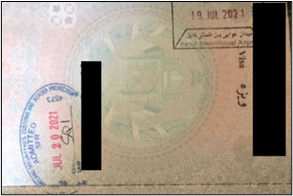
SI LPR and SI CPR – Temporary Form I-551 Stamp[5]
In some situations, an SI LPR or SI CPR will not have an immigrant visa with the Temporary I-551 notation. Instead, they may have a Temporary Form I-551, Permanent Resident Stamp (ADIT stamp) affixed to their foreign passport or to their Form I-94, Arrival/Departure Record, with a photograph of the bearer.
The Form I-551 stamp provides temporary evidence of lawful status until the “Valid Until” date noted on the stamp.


SI and Non-SI Parolee – Form I-766, Employment Authorization Document (EAD)
Afghan SI and non-SI parolees are both paroled into the United States under section 212(d)(5) of the Immigration and Nationality Act and may have a Form I-766, Employment Authorization Document (EAD), with a C11 category and/or a CBP “PAROLED” stamp in their passport.
Form I-766, EAD

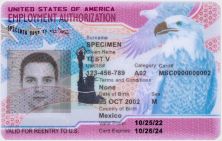
Parole Stamp in Passport with OAR COA
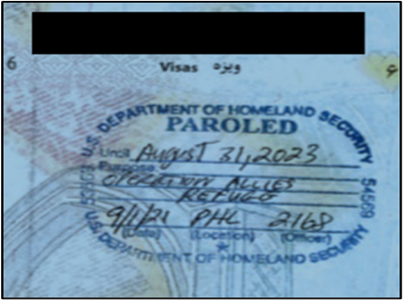
SI Parolee - Form I-94 Arrival/Departure Record with USCIS SQ4/SQ5 Notation
Afghan SI parolees will have a separate, printed page on CBP letterhead with their Form I‑94, Arrival/Departure Record, and the following notation, signed and dated by a USCIS officer:
Special Immigrant Status (SQ/SI) Parolee
Sec 602(b)(1) AAPA / Sec 1059(a) NDAA 2006
Date ______ USCIS officer: ______
Unlike an EAD with a C11 category, which can be issued to both SI and non-SI parolees, this Form I-94 with a USCIS SQ4/SQ5 notation is issued only to Afghan SI parolees.
Form I-94 with CBP DT Parole COA
Changed by USCIS to SQ4/SQ5 SI Parole COA
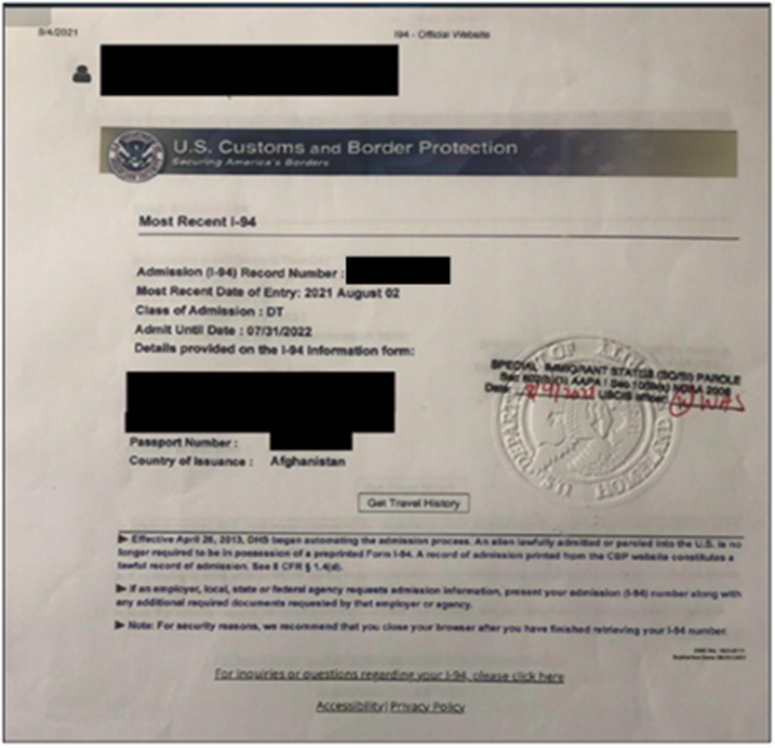
Non-SI Parolee - Form I-94 Arrival/Departure Record with OAR, PAR, or DT COA
Afghan non-SI parolees may also have a Form I-94 printed from the CBP Form I-94 website with a parole COA such as OAR, PAR, or DT.
Form I-94 with OAR COA
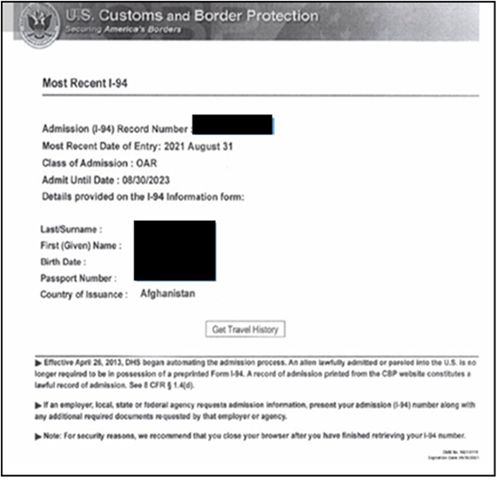
SAVE Verification Process
SAVE user agencies must follow the normal SAVE verification process to verify an Afghan national’s immigration status or parole. SAVE responses verifying any of the Afghan arrival immigration status or parole categories that this sheet addresses will also reflect the COA and/or EAD Category (also referred to as EAD “Provision of Law”) and other information noted in the chart and accompanying notes above. User agencies may verify an applicant’s Afghan citizenship or nationality by following the instructions in the Afghan parolee section of the DHS REAL ID FAQ. If the initial SAVE response does not provide all the immigration information your agency needs, or if your agency or the benefit applicant disagrees with the response, you must submit an additional verification request. In that situation, please note any additional information you need in the comments field for your submission.
Resources
USCIS SAVE
- For the latest information regarding Afghan OAW arrivals, visit the SAVE What’s New page.
- Send questions to your SAVE Agency Relationship Manager or to SAVE.help@uscis.dhs.gov.
- To track the progress of their immigration status verification case, benefit applicants can use SAVE CaseCheck. Benefit granting agencies can provide the verification case number so applicants can check the status of their case online without visiting the agency, and they can receive updates on when to return to the agency.
- For more information visit www.uscis.gov/save.
USCIS
- For Afghan nationals requesting humanitarian parole, information sheets for parolees after being processed on military installations (“safe havens”), vaccine information, as well as information for individuals who may be eligible for Special Immigrant status or already started the process Afghan nationals, visit Information for Afghans.
- For more information, visit www.uscis.gov.
DHS
- For information concerning Operation Allies Welcome, including benefits for Humanitarian Parolees, press releases and statements, Presidential Memorandum, Frequently Asked Questions, and Fact Sheets, visit Operation Allies Welcome.
- For information on the eligibility of Afghan nationals paroled into the United States for REAL ID compliant driver’s licenses and identification cards, visit DHS REAL ID FAQ.
CBP
- To view or download and print an electronic Form I-94 issued by CBP, visit the I-94 – Travel Records for U.S. Visitors.
- For a list of local CBP contacts, visit Deferred Inspection Sites.
- For mobile portal to CBP services, visit CBP One™ Mobile Application.
[1] “OAR” refers to the Operation Allies Refuge (OAR) evacuation effort announced in July 2021. The effort was later renamed Operation Allies Welcome (OAW).
[2] SAVE Additional Verification (AV) may be needed to obtain full SAVE response. AV response may be worded differently than initial response (see Guide to Understanding SAVE Verification Responses), and some information may be in DHS Comments field. Grant Date may be included in SAVE response if your agency is authorized to receive it.
[3] Afghans generally obtain SI LPR status based upon having worked for or on behalf of the U.S. Government or the International Security Assistance Force. However, a small number of Afghans have instead obtained SI LPR status based upon specific past work as translators or interpreters and will have an SI1, SI2, SI3, SI6, SI7, or SI8 COA.
[4] Non-SI parolee is also sometimes referred to as “Afghan humanitarian parole” or “OAR parole.”
[5] The Temporary I-551 stamp is sometimes referred to as an Alien Documentation Identification and Telecommunication (ADIT) stamp.
